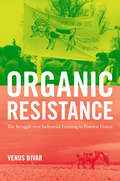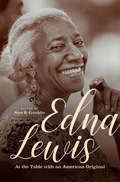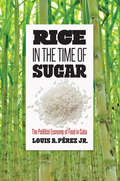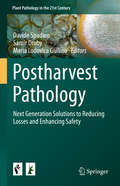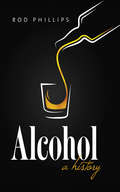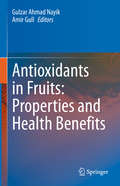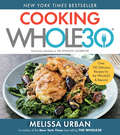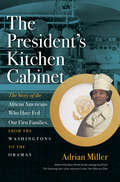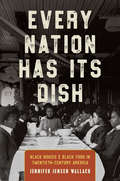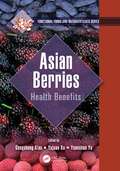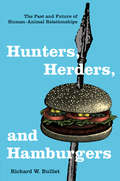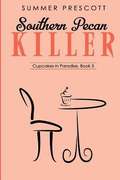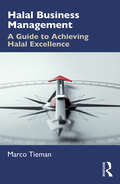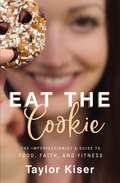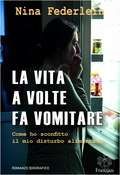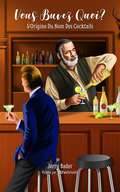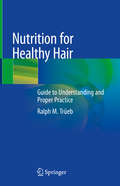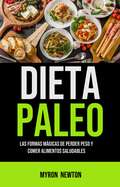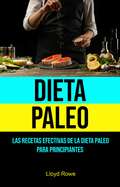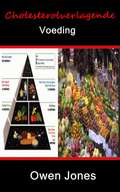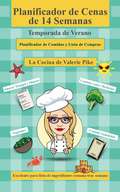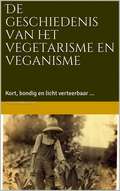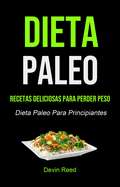- Table View
- List View
Organic Resistance: The Struggle over Industrial Farming in Postwar France (Flows, Migrations, and Exchanges)
by Venus BivarFrance is often held up as a bastion of gastronomic refinement and as a model of artisanal agriculture and husbandry. But French farming is not at all what it seems. Countering the standard stories of gastronomy, tourism, and leisure associated with the French countryside, Venus Bivar portrays French farmers as hard-nosed businessmen preoccupied with global trade and mass production. With a focus on both the rise of big agriculture and the organic movement, Bivar examines the tumult of postwar rural France, a place fiercely engaged with crucial national and global developments.Delving into the intersecting narratives of economic modernization, the birth of organic farming, the development of a strong agricultural protest movement, and the rise of environmentalism, Bivar reveals a movement as preoccupied with maintaining the purity of the French race as of French food. What emerges is a story of how French farming conquered the world, bringing with it a set of ideas about place and purity with a darker origin story than we might have guessed.
Edna Lewis: At the Table with an American Original
by Sara B. FranklinEdna Lewis (1916-2006) wrote some of America's most resonant, lyrical, and significant cookbooks, including the now classic The Taste of Country Cooking. Lewis cooked and wrote as a means to explore her memories of childhood on a farm in Freetown, Virginia, a community first founded by black families freed from slavery. With such observations as "we would gather wild honey from the hollow of oak trees to go with the hot biscuits and pick wild strawberries to go with the heavy cream," she commemorated the seasonal richness of southern food. After living many years in New York City, where she became a chef and a political activist, she returned to the South and continued to write. Her reputation as a trailblazer in the revival of regional cooking and as a progenitor of the farm-to-table movement continues to grow. In this first-ever critical appreciation of Lewis's work, food-world stars gather to reveal their own encounters with Edna Lewis. Together they penetrate the mythology around Lewis and illuminate her legacy for a new generation.The essayists are Annemarie Ahearn, Mashama Bailey, Scott Alves Barton, Patricia E. Clark, Nathalie Dupree, John T. Edge, Megan Elias, John T. Hill (who provides iconic photographs of Lewis), Vivian Howard, Lily Kelting, Francis Lam, Jane Lear, Deborah Madison, Kim Severson, Ruth Lewis Smith, Toni Tipton-Martin, Michael W. Twitty, Alice Waters, Kevin West, Susan Rebecca White, Caroline Randall Williams, and Joe Yonan. Editor Sara B. Franklin provides an illuminating introduction to Lewis, and the volume closes graciously with afterwords by Lewis's sister, Ruth Lewis Smith, and niece, Nina Williams-Mbengue.
Rice in the Time of Sugar: The Political Economy of Food in Cuba
by Louis A. PérezHow did Cuba's long-established sugar trade result in the development of an agriculture that benefited consumers abroad at the dire expense of Cubans at home? In this history of Cuba, Louis A. Perez proposes a new Cuban counterpoint: rice, a staple central to the island's cuisine, and sugar, which dominated an export economy 150 years in the making. In the dynamic between the two, dependency on food imports—a signal feature of the Cuban economy—was set in place.Cuban efforts to diversify the economy through expanded rice production were met with keen resistance by U.S. rice producers, who were as reliant on the Cuban market as sugar growers were on the U.S. market. U.S. growers prepared to retaliate by cutting the sugar quota in a struggle to control Cuban rice markets. Perez's chronicle culminates in the 1950s, a period of deepening revolutionary tensions on the island, as U.S. rice producers and their allies in Congress clashed with Cuban producers supported by the government of Fulgencio Batista. U.S. interests prevailed—a success, Perez argues, that contributed to undermining Batista's capacity to govern. Cuba's inability to develop self-sufficiency in rice production persists long after the triumph of the Cuban revolution. Cuba continues to import rice, but, in the face of the U.S. embargo, mainly from Asia. U.S. rice growers wait impatiently to recover the Cuban market.
Postharvest Pathology: Next Generation Solutions to Reducing Losses and Enhancing Safety (Plant Pathology in the 21st Century #11)
by Maria Lodovica Gullino Davide Spadaro Samir DrobyThe book will address selected topics in postharvest pathology aiming at highlighting recent development in the science, technology and control strategies of postharvest diseases to reduce losses and enhance safety of harvested agricultural products. Topics will include: 1) Introduction: Perspectives and challenges in postharvest pathology 2) Elucidating host-pathogen interactions 3) Next generation technologies for management and detection of postharvest pathogens 4) Food safety in postharvest pathology 5) Alternative postharvest diseases control strategies 6) Chemical control of postharvest diseases
Alcohol: A History
by Rod PhillipsWhether as wine, beer, or spirits, alcohol has had a constant and often controversial role in social life. In his innovative book on the attitudes toward and consumption of alcohol, Rod Phillips surveys a 9,000-year cultural and economic history, uncovering the tensions between alcoholic drinks as healthy staples of daily diets and as objects of social, political, and religious anxiety. In the urban centers of Europe and America, where it was seen as healthier than untreated water, alcohol gained a foothold as the drink of choice, but it has been more regulated by governmental and religious authorities more than any other commodity. As a potential source of social disruption, alcohol created volatile boundaries of acceptable and unacceptable consumption and broke through barriers of class, race, and gender.Phillips follows the ever-changing cultural meanings of these potent potables and makes the surprising argument that some societies have entered "post-alcohol" phases. His is the first book to examine and explain the meanings and effects of alcohol in such depth, from global and long-term perspectives.
Antioxidants in Fruits: Properties and Health Benefits
by Gulzar Ahmad Nayik Amir GullThis book provides a comprehensive review of the antioxidant value of widely consumed fruits. Each chapter covers the botanical description, nutritional & health properties of these popular fruits. Fruits are one of the most important indicators of dietary quality and offer protective effects against several chronic diseases such as cardiovascular diseases, obesity, and various types of cancer. In order to effectively promote fruit consumption, it is necessary to know and understand the components of fruits. In addition to underscoring the importance of fruit consumption’s effects on human diet, the book addresses the characterization of the chemical compounds that are responsible for the antioxidant proprieties of various fruits.Given its scope, the book will be of interest to graduate and post-graduate students, research scholars, academics, pomologists and agricultural scientists alike. Those working in various fruit processing industries and other horticultural departments will also find the comprehensive information relevant to their work.
The Whole30 Cookbook: 150 Delicious and Totally Compliant Recipes to Help You Succeed with the Whole30 and Beyond (The\whole30 Ser.)
by Melissa HartwigStill think the Whole30 is a diet? Not with recipes like these. The groundbreaking Whole30 program has helped countless people transform their lives by bringing them better sleep, more energy, fewer cravings, weight loss, and new healthy habits that last a lifetime. In this cookbook, best-selling author and Whole30 co-creator Melissa Hartwig delivers over 150 all-new recipes to help readers prepare delicious, healthy meals during their Whole30 and beyond. More than 150 recipes for main dishes, sides, dressings, and saucesTips to simplify, plan, and prepare meals to save time and moneyVariations to turn one easy dish into two or three meals Whether you've done the Whole30 once or five times--or just want to make a variety of satisfying, nourishing meals--this book will inspire you to change your life in 30 days with the Whole30 program.
The President's Kitchen Cabinet: The Story of the African Americans Who Have Fed Our First Families, from the Washingtons to the Obamas
by Adrian MillerAn NAACP Image Award Finalist for Outstanding Literary Work—Non FictionJames Beard award–winning author Adrian Miller vividly tells the stories of the African Americans who worked in the presidential food service as chefs, personal cooks, butlers, stewards, and servers for every First Family since George and Martha Washington. Miller brings together the names and words of more than 150 black men and women who played remarkable roles in unforgettable events in the nation's history. Daisy McAfee Bonner, for example, FDR's cook at his Warm Springs retreat, described the president's final day on earth in 1945, when he was struck down just as his lunchtime cheese souffle emerged from the oven. Sorrowfully, but with a cook's pride, she recalled, "He never ate that souffle, but it never fell until the minute he died." A treasury of information about cooking techniques and equipment, the book includes twenty recipes for which black chefs were celebrated. From Samuel Fraunces's "onions done in the Brazilian way" for George Washington to Zephyr Wright's popovers, beloved by LBJ's family, Miller highlights African Americans' contributions to our shared American foodways. Surveying the labor of enslaved people during the antebellum period and the gradual opening of employment after Emancipation, Miller highlights how food-related work slowly became professionalized and the important part African Americans played in that process. His chronicle of the daily table in the White House proclaims a fascinating new American story.
Every Nation Has Its Dish: Black Bodies and Black Food in Twentieth-Century America
by Jennifer Jensen WallachJennifer Jensen Wallach's nuanced history of black foodways across the twentieth century challenges traditional narratives of "soul food" as a singular style of historical African American cuisine. Wallach investigates the experiences and diverse convictions of several generations of African American activists, ranging from Booker T. Washington and W. E. B. Du Bois to Mary Church Terrell, Elijah Muhammad, and Dick Gregory. While differing widely in their approaches to diet and eating, they uniformly made the cultivation of "proper" food habits a significant dimension of their work and their conceptions of racial and national belonging. Tracing their quests for literal sustenance brings together the race, food, and intellectual histories of America.Directly linking black political activism to both material and philosophical practices around food, Wallach frames black identity as a bodily practice, something that conscientious eaters not only thought about but also did through rituals and performances of food preparation, consumption, and digestion. The process of choosing what and how to eat, Wallach argues, played a crucial role in the project of finding one's place as an individual, as an African American, and as a citizen.
Black Food Geographies: Race, Self-Reliance, and Food Access in Washington, D.C.
by Ashanté M. ReeseIn this book, Ashante M. Reese makes clear the structural forces that determine food access in urban areas, highlighting Black residents' navigation of and resistance to unequal food distribution systems. Linking these local food issues to the national problem of systemic racism, Reese examines the history of the majority-Black Deanwood neighborhood of Washington, D.C. Based on extensive ethnographic fieldwork, Reese not only documents racism and residential segregation in the nation's capital but also tracks the ways transnational food corporations have shaped food availability. By connecting community members' stories to the larger issues of racism and gentrification, Reese shows there are hundreds of Deanwoods across the country. Reese's geographies of self-reliance offer an alternative to models that depict Black residents as lacking agency, demonstrating how an ethnographically grounded study can locate and amplify nuances in how Black life unfolds within the context of unequal food access.
Asian Berries: Health Benefits (Functional Foods and Nutraceuticals)
by Gengsheng Xiao Yujuan Xu Yuanshan YuAs consumers look to natural foods to promote health and well-being, their focus has been on foods with recognized health properties. Natural health products with rich antioxidant and high free radical scavenging activity such as Asian berries currently draw the interest of scientific researchers, whose goal is to evaluate Asian berries’ nutritional and health-promoting properties. Collected in one source, Asian Berries: Health Benefits covers a wide array of different Asian berries, their properties, potential health benefits, and possible uses. Asian berries are well-known traditional nutritional foods and herbal medicinals as well as valuable nourishing tonic, which has been used for thousands of years in Asian countries. They are traditionally employed as herbal medicinals from ancient times. Recently, Asian berries widely marketed as health foods have become increasingly popular in the Western world because of their health-promoting properties. This book explores a wide array of possibilities and benefits that come from Asian berries. Key Features: Defines chemical, biochemical properties, bioactive components and health benefits of Asian berries Details postharvest storage technology and processing technology development Explains utilization of Asian berries by-products Discusses Asian berries functional foods as well as food safety issues Complete with 18 chapters written by experts in their field, Asian Berries: Health Benefits serves as an excellent reference for anyone interested in the science and technology of bioactive components from Asian berries as health-promoting foods.
Hunters, Herders, and Hamburgers: The Past and Future of Human-Animal Relationships
by Richard BullietRichard W. Bulliet has long been a leading figure in the study of human-animal relations, and in his newest work, Hunters, Herders, and Hamburgers, he offers a sweeping and engaging perspective on this dynamic relationship from prehistory to the present. By considering the shifting roles of donkeys, camels, cows, and other domesticated animals in human society, as well as their place in the social imagination, Bulliet reveals the different ways various cultures have reinforced, symbolized, and rationalized their relations with animals. Bulliet identifies and explores four stages in the history of the human-animal relationship-separation, predomesticity, domesticity, and postdomesticity. He begins with the question of when and why humans began to consider themselves distinct from other species and continues with a fresh look at how a few species became domesticated. He demonstrates that during the domestic era many species fell from being admired and even worshipped to being little more than raw materials for various animal-product industries. Throughout the work, Bulliet discusses how social and technological developments and changing philosophical, religious, and aesthetic viewpoints have shaped attitudes toward animals.Our relationship to animals continues to evolve in the twenty-first century. Bulliet writes, "We are today living through a new watershed in human-animal relations, one that appears likely to affect our material, social, and imaginative lives as profoundly as did the original emergence of domestic species." The United States, Britain, and a few other countries are leading a move from domesticity, marked by nearly universal familiarity with domestic species, to an era of postdomesticity, in which dependence on animal products continues but most people have no contact with producing animals. Elective vegetarianism and the animal-liberation movement have combined with new attitudes toward animal science, pets, and the presentation of animals in popular culture to impart a distinctive moral, psychological, and spiritual tone to postdomestic life.
Southern Pecan Killer (Cupcakes in Paradise #5)
by Summer PrescottOut of the mouths of babes... A murder is a terrible thing to witness, particularly if you're three years old. Cupcake baker Melissa Beckett is an amateur sleuth faced with the most heartbreaking case of a lifetime. An apparent murder/suicide haunts her sleepy beachside town of Calgon, Florida, and local Coroner, Timothy Eckels, discovers some clues that prove to be quite chilling. An orphaned young child may be the only witness to the tragic event, and her bond with Missy's new employee, Aunt Beulah, may be Missy's last hope of finding out what really happened, Melissa Beckett is faced with a life-changing decision, once the terrible truth of the case comes out...will her life ever be the same? This exciting Cozy Mystery can be read as a standalone, but if you'd like to know more about Missy, Chas and the rest of the Calgon gang, their history can be found in the two series previous to this one. The first Missy and Chas series is Frosted Love Cozy Mysteries, and the second is The INNcredibly Sweet Series. Enjoy them all!
Rick Steves London 2020 (Rick Steves Travel Guide)
by Rick Steves Gene OpenshawFrom the sacred stones of Westminster Abbey to the top of the London Eye, the city is yours to discover with Rick Steves! Inside Rick Steves London 2020 you'll find:Comprehensive coverage for spending a week or more exploring LondonRick's strategic advice on how to get the most out of your time and money, with rankings of his must-see favoritesTop sights and hidden gems, from Trafalgar Square and the Tower of London to where to find the best tikka masala or fish and chipsConnect with local culture: Catch a show in Soho, take afternoon tea, or have a pint of English ale with Londoners in a pub Beat the crowds, skip the lines, and avoid tourist traps with Rick's candid, humorous insightThe best places to eat, sleep, and relax with a Pimm's CupSelf-guided walking tours of lively neighborhoods and world-class museums like the British Museum and the Victoria & Albert Day trips to Windsor, Cambridge, and StonehengeDetailed neighborhood maps and a fold-out city map for exploring on the goUseful resources including a packing list, popular British slang, a historical overview, and recommended readingOver 600 bible-thin pages include everything worth seeing without weighing you downMake the most of every day and every dollar with Rick Steves London 2020.Spending just a few days in the city? Try Rick Steves Pocket London.
Halal Business Management: A Guide to Achieving Halal Excellence
by Marco TiemanThe halal industry is a fast-growing industry due to demographics and industry expansion. Halal certification of products, outlets, and services is essential for doing business in Muslim-majority countries. This book shares the building blocks of professional halal business management, covering halal certification, halal supply chain management, branding and marketing, and halal risk and reputation management. Drawing on years of academic research and advisory experience, the book provides practical advice and guidance on how best to organise and upscale your halal business operations. Successful companies in the halal industry are those that embrace halal excellence by design. Halal excellence is a process – a pursuit of excellence. Halal business management is beyond halal certification, and needs to address supply chain management, branding and marketing, and risk and reputation management. Halal excellence needs measurement through adopting the right key performance indicators, to protecting your halal reputation and licence to operate in Muslim markets. This book gives proven, practical strategies to guide you in the halal industry. The book is for all organisations involved in serving Muslim markets, and also serves as a coursebook for graduate and postgraduate education in halal business management.
Eat the Cookie: The Imperfectionist’s Guide to Food, Faith, and Fitness
by Taylor KiserFinally--a real-life plan for eating and thinking healthy. Nutrition and fitness coach Taylor Kiser's Eat the Cookie is your invitation to give yourself the grace to be both a masterpiece and a work in progress.From diets to detoxes to fitness plans, there's no shortage when it comes to plans for perfection.But what happens when our quest for health and perfection leads to fear, insecurity, and over-control? Written with her characteristic straight talk and humor, Taylor Kiser draws insights from her own journey to help you find freedom from the impossible quest of perfection.Whether you struggle with body image, eating disorders, unhealthy habits, or the never-ending comparison game, Eat the Cookie provides an easy-to-follow roadmap to spiritual and physical health. Each chapter delivers God's truth to help you redefine your identity in healthy ways, embrace progress over perfection, and use practical tools--such as never-before-published recipes and fitness plans--to love and care for the body God gave you.Taylor understands the pendulum swings we experience with our weight and self-perception. She knows what it's like to let fear of falling short turn into a belief that you're not worthy, and this belief turned into destructive habits that controlled her life for far too long. Now a certified nutrition and fitness coach, Taylor enjoys eating a cookie now and then, even as she enjoys discovering recipes and habits that give her renewed physical energy and health. In Eat the Cookie, you'll learn the secrets of balance that can help us all live health-conscious without being calorie-obsessed.
La vita a volte fa vomitare: Come ho sconfitto il mio disturbo alimentare
by Nina FederleinPurtroppo, i disturbi psicosomatici sono molto comuni oggi. Le persone affette e l'ambiente circostante spesso sperimentano una forte sensazione di impotenza in considerazione del quadro clinico e del decorso di tali patologie. In questo libro l'autore racconta la storia della sua malattia. Le pagine del diario e il racconto rivelano al lettore in modo esplicito e indiscutibile la costellazione di pensieri e tormenti quotidiani che hanno plasmato la vita dell'autore durante i sette anni di lotta ai disturbi alimentari. Ma danno anche speranza per una vita piena: nonostante l'anoressia - in seguito bulimia, depressione e disturbo borderline - l'autore è riuscito a rompere il circolo vizioso e ora vive una vita sana e felice con il marito ei suoi due figli. Nina Federlein: “C'è una storia dietro ogni disturbo alimentare. Questo è mio."
Vous Buvez Quao?: L'Origine Du Nom Des Cocktails
by Jerry BaderVous Buvez Quao? L'Origine Du Nom Des Cocktails Publié par MRPwebmedia Pourquoi nomme-t-on les boissons à base d’alcool ‘cocktails’? D’où tirent-ils leur nom exotique: des noms comme Singapore Sling, Screwdriver, Alamagoozlum, Angel’s Kiss, Hanky Panky, Harvey Wallbanger, Sex On The Beach, Monkey Gland, Brass Monkey, Margarita, Japalac, Lion’s Tail, et bien d’autres encore ? Qui a trouvé leur nom, où ont-ils été inventés, pourquoi, et comment les réaliser? Les réponses à ces questions se trouvent dans Vous buvez quoi? un panorama à travers des faits, personnes et lieux qui entrent dans le processus de création de ces préparations exotiques.
Nutrition for Healthy Hair: Guide to Understanding and Proper Practice
by Ralph M. TrüebThe quantity and quality of the hair are closely related to the nutritional state of an individual. And yet, there is hardly another field with so much prejudice, misconception, and debate as diet and health, let alone hair health. Pharmacy aisles and Internet drugstores are full of nutritional supplements promising full, thick, luscious hair for prices that range from suspiciously cheap to dishearteningly exorbitant. Since there lies an important commercial interest in the nutritional value of various nutritional supplements, a central question that arises is whether increasing the content of an already adequate diet with nutrients may further promote hair growth and quality. This book aims at distinguishing facts from fiction, and at providing a sound scientific basis for nutrition-based strategies for healthy hair, at the same time acknowledging the problems and limitations of our current understanding and practice.
Paleo Diet: Las Formas Mágicas De Perder Peso Y Comer Alimentos Saludables
by Myron NewtonEste libro contiene pasos comprobados y estrategias para adquirir una dieta paleo exitosa de forma simple y sin complicaciones que lo llevarán a disfrutar de un estilo de vida paleo con una barriga llena y un paladar satisfecho. No solamente la dieta Paleo lo llevará de vuelta a la forma de comer alimentos de buena calidad, sino también a una dieta completamente saludable. El uso de esta dieta le abrirá un gran rango de ventajas; como reducir riesgos a su salud, multiplicar su resistencia y energía y, lo que es más importante para algunos seguidores de la dieta Paleo; controlar y reducir el peso a los niveles deseados. Decidirse por seguir una dieta es más fácil decirlo que hacerlo. Hay muchos factores no tan favorables a considerar. Afortunadamente para usted, no guardo nada. Dentro de estas páginas, encontrará de qué se trata realmente la dieta Paleo para que pueda evaluar adecuadamente sus méritos y decidir si es un compromiso de vida diseñado para usted o no. ¡Descargue el libro ahora!
Dieta Paleo: Paleo Dieta para principiantes, pierde peso y vuélvete saludable por Lloyd Rowe
by Lloyd RoweUna vez que eliminas el daño ocasionado por los alimentos cultivados y procesados que hemos añadido a nuestra dieta, tu cuerpo empieza a recuperar su resistencia natural a los padecimientos y enfermedades. El hombre del Paleolítico tenía una reducida calidad de vida ya que no tenían los cuidados médicos adecuados, no debido a las enfermedades en sí. No sufría de enfermedades del corazón o diabetes como nosotros. Este libro contiene pasos comprobados y estrategias de como alimentarse con la paleo dieta. La paleo dieta consiste en resetear el cuerpo para que pueda funcionar a sus máximos niveles de salud. Alimentarse con una dieta similar a la de nuestros ancestros cavernícolas, cientos de siglos atrás, hace esto. Incluye alimentos que pueden encontrarse en la naturaleza, como frutas, vegetales, nueces y carnes.
Cholesterolverlagende Voeding (Hoe ... #23)
by Owen JonesHallo, bedankt voor het kopen van mijn e-book ‘Cholesterolverlagende Voeding’. Ik hoop dat deze informatie nuttig voor u zal zijn u en dat u er zelfs voordeel zal kunnen uithalen. De informatie in dit e-book over cholesterol en aanverwante onderwerpen is opgedeeld in 17 hoofdstukken van ongeveer elk 500-600 woorden. Het zal u helpen om uw cholesterolwaarden beter te begrijpen en onder controle te houden, en het kan u zelfs helpen om van de medicatie af te blijven. Als bonus krijgt u de toestemming om de inhoud te gebruiken op uw eigen website of in uw persoonlijke blogs en nieuwsbrief, hoewel het beter is om de inhoud eerst in uw eigen woorden te herschrijven. U mag het boek ook opsplitsen en de artikels doorverkopen. Het enige recht dat u eigenlijk niet heeft is het boek doorverkopen of weggeven omdat u het zelf heeft aangekocht. Heeft u feedback? Contacteer dan het bedrijf waar u het boek kocht. Nogmaals bedankt voor de aankoop van dit e-book,
Planificador de cenas de 14 semanas. Temporada de Verano
by Valerie PikeHola, como les ha ido con mis otros dos libros, les presento mi tercer libro de cocina de mi serie “Planificador de cenas para 52 semanas”. La temporada de verano, para mí se traduce en vacaciones, tiempo de calidad con la familia, compartir en la playa, lago o montaña, donde sea el lugar preferido de descanso y esparcimiento. Que mejor manera de disfrutarlo que preparar las deliciosas recetas que les introduzco en este libro. Esta temporada va entre junio y agosto. Así que vamos, celebremos con todas estas recetas deliciosas y fáciles de hacer. Incluí 14 semanas de recetas y sus listas de compras correspondientes. Los pasillos en que he agrupado las listas de compras de ingredientes siguen a la tienda de comestibles de Ralph en mi ciudad natal. Otras tiendas de comestibles tendrán los artículos agrupados de manera similar. Compartiré con ustedes a lo largo de este libro, 169 recetas deliciosas y fáciles que he recopilado en mi experiencia sobre cocina saludable y todas vienen con su lista de compras. Así que manos a la obra a cocinar y disfrutar todas estas delicias con la familia.
De geschiedenis van het vegetarisme en veganisme: Kort, bondig en licht verteerbaar...
by Daniel HagenWe leven al zo'n tien generaties in het industriële tijdperk. Een tijdperk waarin het snel gaat. Het menselijk ras is in overdrive! Ook qua voeding. Vlees is goedkoop geworden, in massa geproduceerd We eten zongerijpte papaja's in hartje winter. Noordzeegarnalen worden gevangen in de Noordzee, gepeld in Marokko en vervolgens 'vers gevangen' gegeten in Noord-Duitsland. In de onderwaterwereld heeft plastic voorrang op het leven in zee. In het ene deel van de wereld lijden nog steeds veel mensen aan ondervoeding - in het andere deel komt steeds meer en meer obesitas, diabetes, enz voor. Met het oog hierop zou je kunnen denken dat de vegetariër, evenals de veganistische voedingsfilosofie in de vervolgopleiding, een heel jong fenomeen is dat voornamelijk ontsprongen is uit de geprivilegieerde sociale perspectieven van de Eerste Wereld. Maar dat is verre van zo!
Dieta Paleo: Recetas Deliciosas Para Perder Peso (Dieta Paleo Para Principiantes)
by Devin ReedUno оf thе beneficios de la dieta Paleo es el incremento de energía. Tendrás tanta energía que no sabrás qué hacer con ella. Algunas personas dicen que se sienten más jóvenes y otros mencionan tener más energía de la que recuerden haber tenido jamás. Este libro contiene pasos y estrategias probadas sobre cómo vivir el estilo de vida Paleo. En el período prehistórico, las personas consumían alimentos orgánicos, cultivados naturalmente. Recogían frutas y verduras silvestres, cazaban su propia carne, bebían principalmente agua y complementaban sus dietas con nueces y semillas. Este tipo de estilo de vida tuvo muchos beneficios para la salud. De hecho, nuestros antepasados no sufrían de hipertensión, cáncer, diabetes, entre otros. Piénsalo: el ser humano Pаlео tuvo que tener un montón de energía para su día a día, pues estaba centrado en la supervivencia. Su dieta lo mantenía durante el equivalente a caminatas diarias de diez millas y también para huir de los depreadores o para levantar objetos pesados.
